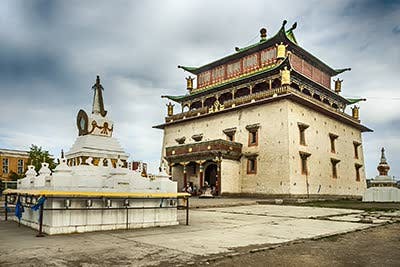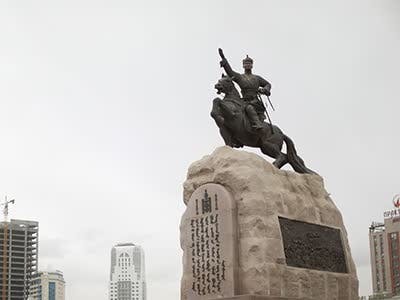Gandan Monastery
ABOUT GANDAN MONASTERY
Gandan Monastery, also known as Gandantegchinlen Monastery, is a prominent Buddhist monastery located in Ulaanbaatar, the capital city of Mongolia. It is one of the largest and most important monasteries in the country and serves as a center for Buddhist worship, education, and cultural preservation. Here are some key features and highlights of Gandan Monastery:
.jpg?alt=media&token=f05d189c-4fca-4a94-af2d-5612fe3713e2)
GOOD TO KNOW
- History and Significance: Gandan Monastery was established in 1838 and has played a significant role in preserving and promoting Buddhism in Mongolia. It survived the religious purges of the socialist era and has since regained its importance as a religious and cultural institution.
- Architecture: The monastery's architecture is a blend of Tibetan, Mongolian, and Chinese influences. The main temple, known as the Migjid Janraisig Sum, is a magnificent structure with golden roofs, intricate artwork, and colorful murals. The architecture reflects the Tibetan Buddhist style, characterized by its grandeur and spiritual symbolism.
- Migjid Janraisig Statue: The main attraction of Gandan Monastery is the impressive Migjid Janraisig statue, also known as the Avalokitesvara or Chenrezig statue. It stands at a height of 26.5 meters (87 feet) and is adorned with gold and precious stones. The statue is a symbol of compassion and is believed to grant blessings to those who visit and make offerings.
- Monastic Life: Gandan Monastery is home to hundreds of monks who reside and study within its premises. Visitors can witness the daily rituals and practices of the monks, including prayer ceremonies, chanting, and meditation. The monastery provides a glimpse into the monastic way of life and offers opportunities for spiritual exploration and learning.
- Temples and Chapels: The monastery complex consists of various temples and chapels dedicated to different deities and Buddhist figures. Each temple has its unique decorations, religious artifacts, and sacred objects. Visitors can explore these sacred spaces, admire the intricate artwork, and experience the serene atmosphere of devotion.
- Tsam Dance Performances: Gandan Monastery is known for its vibrant Tsam dance performances. Tsam is a traditional masked dance that depicts Buddhist legends, teachings, and spiritual rituals. The performances take place during special religious festivals and are a visual spectacle, showcasing colorful costumes, elaborate masks, and choreographed movements.
- Library and Museum: The monastery houses a library and a museum that preserve and display a vast collection of Buddhist scriptures, religious texts, and historical artifacts. The library is an important resource for scholars and researchers interested in Buddhist studies and Mongolian history.
Gandan Monastery is not only a place of religious worship but also a cultural and educational center that offers visitors an opportunity to immerse themselves in Mongolian Buddhist traditions, art, and history. It serves as a significant spiritual and architectural landmark in Ulaanbaatar and attracts both locals and tourists who seek to connect with the Buddhist heritage of Mongolia.
RELATED DESTINATIONS
Gandan Monastery, also known as Gandantegchinlen Monastery, is a prominent Buddhist monastery located in Ulaanbaatar, the capital city of Mongolia. It is one of the largest and most important monasteries in the country
Sukhbaatar Square is a central square located in Ulaanbaatar, the capital city of Mongolia. It is named after Damdin Sukhbaatar, a national hero who played a significant role in Mongolia's independence from China in 1921
The National Museum of Mongolian History is a prominent museum located in Ulaanbaatar, the capital city of Mongolia. It is dedicated to preserving and showcasing Mongolia's rich history, culture, and heritage.


